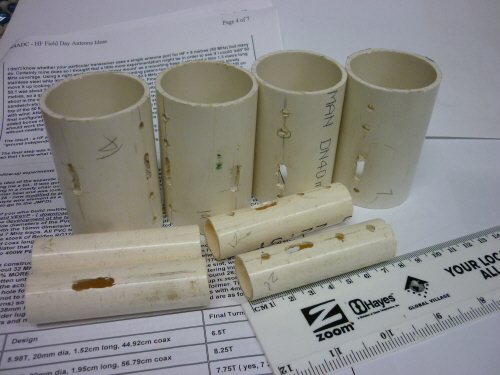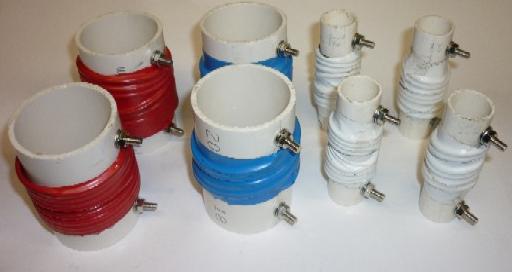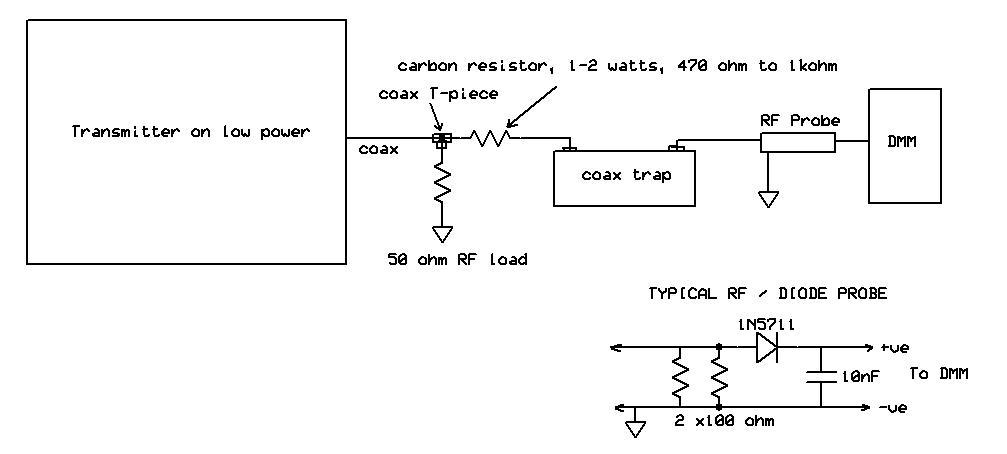|
The problem with making your own trapped HF antennas is usually getting the coaxial traps tuned to frequency. Some try to use a GDO (grid dip oscillator, or its solid state equivalent) but the typical dial frequency calibration on one of these is usually poor anyway. The other problem is that the actual GDO frequency will usually "pull" a bit away from the dial calibration depending on the level of inductive coupling as it goes close to resonance so, again,that method is useful but is neither quick nor accurate.
Most people try to do it this way - they use the GDO to find the "dip" and rely on the accuracy of the GDO dial. Move the coil turns then dip again & so on to get it onto frequency, maybe using the station receiver to confirm frequency. The GDO is inherently unstable (it is an unshielded free-running oscillator after all...) so even trying to find it on a receiver can be an issue. This process is very slow and prone to errors depending on how close the GDO coil is to the trap - that is if you can even see the dip on the GDO.
By the way, a good starting-point calculator for coax traps for multiband wire antennas is the Coaxial Trap Design software by Tony Field VE6YP - { download: coaxtrap.zip & read the HELP ! }
My technique is to use my Marconi RF signal generator at +10dBm output into the coaxial trap (wired in series) and thence into a RF probe and then into a DMM (an analogue meter is preferred though). All wires to be as short as possible.

I set the sig gen to the wanted frequency ( eg 28.300, 21.200, 14.200, 7.080...) and start expanding or compressing the trap turns coarsely on the former by hand until I see the DMM voltage (2V or 4V range) start to drop. I then use an insulated alignment tool to fine-tune the turns and when I am close then I start winding insulation tape around the first 1/3rd of the winding, re-check, next 1/3rd, recheck and fine tune again and finally the last bit bar one turn. This last turn is carefully adjusted for the bottom of the voltage dip before the last of the insulation tape is wound on.
You can then check the actual frequency by moving the sig gen frequency up or down slightly (eg in 10KHz steps) to find the actual trap resonant frequency, as indicated by the absolute minimum voltage reading on the indicator meter. It is a good practice to write the actual frequency onto the trap former with a permanent marker so you know exactly which band it is resonant on.
By using the above technique, I can get the traps for each side of the dipole/V quickly tuned within 100KHz of each other without any problems. One thing I must mention is that my coax traps ALWAYS have extra coax (up to 5-10% above the calculated value) in their construction and are thus always low in frequency and this technique works because spreading the turns raises the frequency. My trap formers are usually slotted towards one end to make it easy to spread the turns. Of course you can always cut a short length off the coax to increase frequency but it is usually a major rewind if it is too short to begin with.
You can also use this same technique to check the tuning of the traps from multi-band yagis although the connection arrangements have to be done with care.

These formers are ready to wind some new traps for a multiband inverted-V for HF field day operations.

The trap pairs left to right are 7, 14, 21 and 28 MHz.
See also my pages about field day antennas and the W8010 modifications using about coax traps.
If you don't have a suitable sig gen then use the HF transceiver set to the wanted frequency on it's lowest transmitter RF output power setting ( < 1 watt) into a 50 ohm dummy load via a T-piece and then use a piece of coax with a 470ohm to 1Kohm 1-2W series carbon resistor into the trap input and use the same adjustment procedure as above. Don't use an inductive style series resistor, and by the way, this series resistor is actually part of an attenuator network to keep the RF power applied to the RF probe low - DON'T OMIT IT.

-------------------------------------------------------------------------
While searching for something else recently, I came across a web page ( http://www.marcspages.co.uk/tech/2104.htm ) that uses the trap assembly ( conventional LC or coax styles ) in the coupling path between two induction loops. The same arrangement was found elsewhere at http://www.qsl.net/dk7zb/Trap/trap.htm and that one was accompanied by a series of photos that provide good insight into the construction of the coupling loops & the physical testing arrangements.

(Marc's image)
The RF source is a suitable transmitter at a low RF power level (typically 1-2 watts) into one side. The pickup loop is then fed into some form of detector - an RF probe, suitable high frequency oscilloscope..
In many ways, the RF probe with an analogue meter is the best option as it makes the signal peak a lot easier to discern.
Just a suggestion, if you already have a good 50 ohm dummy load, make up a cable from the SWR meter that puts the coupling loop in the centre conductor circuit (instead of the 50 ohm load) and then take the other side of the loop to a coax connector and screw the 50 ohm load onto that. Doing so puts the one side of the RF load at 'ground', and the coupling loop at full RF - but since the coupling is 'loose' and the RF power is low, no real safety issues should occur.
It is possible to just use the SWR meter to tune the traps but don't forget to include the in-line 50 ohm resistor ( of a suitable construction for HF and power rating ) - as shown above. The trap's resonant frequency is where the SWR is highest - typically as found by changing the transceiver's frequency. Alternatively, the procedure could be as I suggested further above - set the transmitter frequency and then adjust the trap frequency by spreading or compressing the turns so that the SWR peaks there.
Finally, you can even omit the SWR meter and just use the pickup-loop detector method. Trap resonance coincides with maximum signal at the detector in this arrangement.
Or, as Marc suggests, there is no reason that you cannot use both indication methods similtaneously.
The only thing about this coupling methodology is that it can't be used for tubing antenna traps ( eg from trap-style yagis - tribanders...) - you can't really inductively couple to them - but my method using direct connections further up the page works with ANY style of antenna trap !
|